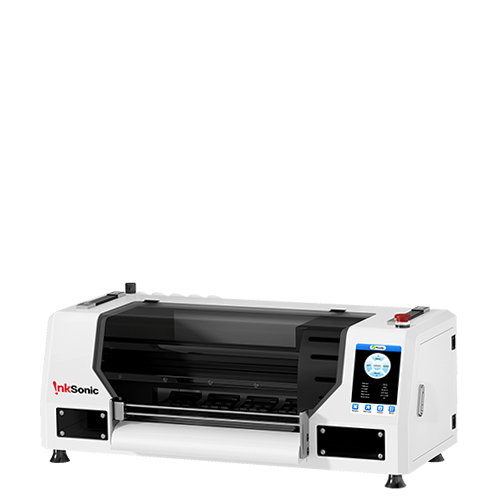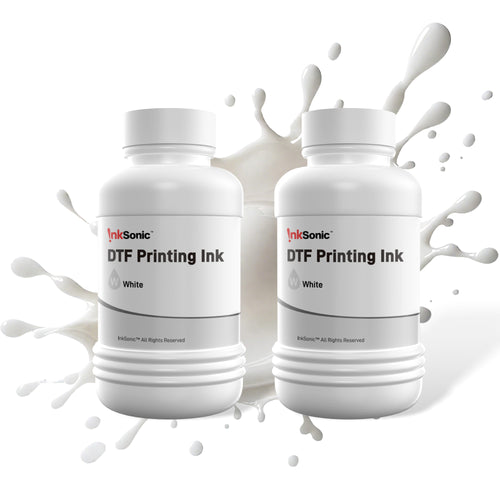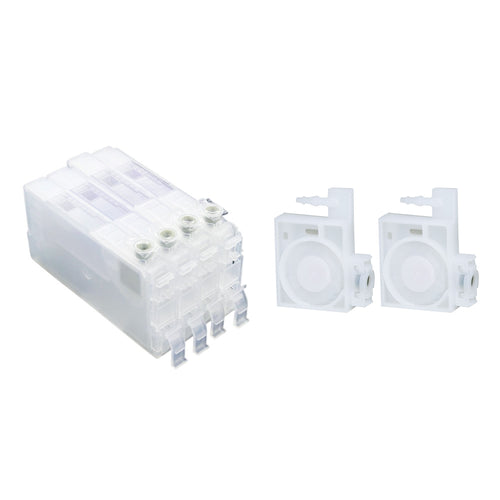If you own a DTF printer, following these 12 industry-certified recommendations as an operational manual will definitely extend your printer’s lifespan and enhance its performance. This article covers everything from the basics to advanced tips—you’ll remember them all after reading.
1. Use High-Quality Ink and Consumables


Inks and transfer consumables in DTF printing play a crucial role in final product quality. Most newbies save money on cheap, non-branded consumables—but this tends to bite back, leading to machine damage and money losses.
Low-quality inks (especially white ink) are chemically unstable, prone to sedimenting or agglomerating, or flowing poorly—both clogging print heads or even damaging electronics. Defective print heads are costly and shut down production. Cheap hot-melt powders also melt unpredictably, leading to overflow of ink, inferior adhesion, or washing away after application—preventing durability and appearance.
Furthermore, DTF printer manufacturers are always using their inks to calibrate the printer. Different brands use different DTF ink formulas and ICC profiles—mixing brands may result in color differences, instability, and loss of accuracy.
Inksonic recommends:
- Only purchase brand-certified consumables or, more precisely, use materials recommended by the original equipment manufacturer.
- Store DTF printer consumables in a cool, dry place away from direct sunlight.
- Shake white ink regularly to avoid sedimentation.
2. Maintain Daily Basic Cleaning

Spending 5–10 minutes daily on simple cleaning can effectively prevent nozzle clogging and color deviations. This mainly includes inspecting printheads, testing nozzles, and checking ink cartridges. Daily inspection and maintenance involve:
- Printhead Nozzles:
Check if the printhead surface is dirty or has ink residue and clean promptly with a lint-free cloth.
- Nozzle Check Pattern:
Observe if all colors are complete; perform simple nozzle cleaning if necessary.
- Cleaning Unit:
Check the capping station and wiper blade, clean all dried ink to ensure effective cleaning; inspect the waste ink tank for cleaning needs; and ensure the cleaning unit operates normally during nozzle cleaning (observe for ink leaks or malfunctions).
- Ink Tank:
Check if DTF ink levels are sufficient.
- DTF Ink System:
Inspect for air bubbles in the Ink tube, check if the ink dampers leak, and ensure the ink level does not exceed ¾ full.
- Overall Printer:
Wipe inks around the printhead, dust on the printing platform, and check if the paper pressing roller needs cleaning. For weekly and monthly cleaning and maintenance checklists, please refer to Do All DTF Printers Need Daily Maintenance?
3. Optimal Temperature & Humidity for Better Printing
The printing environment heavily influences DTF printer performance, print quality, and consumable behavior. This factor is easily ignored
Why are temperature and humidity so critical?
- Low humidity (<40%) – ink dries in the nozzle; static builds on PET film, causing poor image placement
- High humidity (>65%) – DTF powder absorbs moisture, hardens during transfer, weakening adhesion or causing bleeding
- Temperature extremes affect ink flow, heat-press settings, and even electronics
Recommended Environmental Factors:
- Temperature range: 20°C – 28°C (optimal)
- Humidity range: 45% – 60% (relative humidity)
This “golden environment zone” ensures stable ink jetting, vibrant pattern transferring well, even DTF powder melting, and minimal static interference.
Printing Environment Layout Suggestions:
- Avoid equipment near windows, drafts, or direct sunlight
- Consider climate control or humidifiers/dehumidifiers
- Keep your workspace dust‑free to avoid gloss loss or internal contamination
4. Store Your DTF Printer and Supplies Right

To ensure the printer and consumables can immediately handle high-intensity production after a long trip, the following storage recommendations apply:
DTF Printer Storage:
- Power off and unplug to prevent circuit board aging or damage caused by lightning strikes or voltage fluctuations.
- Cover the printer externally with dust-proof cloth or covers to prevent dust from entering key parts like rails, belts, and ink stacks, affecting startup.
- Keep the indoor environment friendly for the printer.
DTF Ink Storage:
- Always tightly seal ink bottles, especially opened white ink bottles, to prevent air exposure from accelerating degradation.
- Store ink in a cool, dry place away from heat or direct sunlight.
- Gently shake white ink every few days to prevent pigment sedimentation and clumping, ideally every 3–5 days for about 10 seconds each time.
- Do not mix inks from different brands or use cross-brand inks in the same printer to avoid chemical reactions or compatibility issues.
DTF Powder Storage:
- Seal used hot melt glue powder bags tightly or use airtight containers to prevent moisture absorption and clumping.
- Store in a dry room with temperature below 30°C and humidity below 60%.
- In high humidity areas, store with desiccants or in drying cabinets to improve moisture resistance.
- Clumped powder severely affects pattern adhesion and can cause peeling; check regularly.
DTF Transfer Film Storage:
- Store rolls upright or horizontally flat to avoid bending, creases, or deformation from long-term tilting.
- Control storage temperature between 15°C–30°C, away from windows, heat sources, or strong direct light.
- Use dustproof or lightproof bags for sealed storage to prevent dust, grease, or moisture intrusion.
- For film stored long-term, conduct test prints to ensure coating performance remains intact.
Equipment and Consumables Segregated Storage:
- Store machines and consumables separately to avoid heat from equipment affecting consumables.
- Label all storage areas with storage dates and batch numbers to facilitate management and rotation.
- Install dehumidifiers or drying cabinets during humid or rainy seasons to extend consumable shelf life.
5. Boost Your Print Quality with Smart DTF Settings

Before shipment, most DTF printer manufacturer configures exclusive ICC color profiles based on their print head, inks, and consumables. These profiles precisely control ink volume, color balance, and drying time during printing.
This file acts as the “color brain” of the printing system and is decisive for output quality. For example, Inksonic provides three different ICC profiles for different printing scenarios. Misusing settings can cause:
- Excessive ink layers cause pattern edges to blur, transfer difficulty, or incomplete peeling.
- Misalignment of white and color inks leads to blurred edges and poor image clarity.
- Inconsistent drying time causes smudging, misalignment, or ink dragging.
- Printhead overload causes accelerated wear, overheating, clogging, or damage.
Therefore, always use the original ICC files and recommended DTF printer settings from the manufacturer. Avoid reckless color adjustments; if needed, consult Inksonic technical support for professional help to ensure print quality and equipment stability.
For Inksonic U13 users, recommended settings include:
On “Flash Spray” function:
This feature periodically sprays a small amount of ink during printing to keep the printhead moist and prevent clogging, especially for large patterns or intermittent printing.
It also helps quickly detect nozzle failures through interruption or misalignment warnings, allowing prompt maintenance and preventing severe clogging or damage.
On “Feathering” function:
Feathering adds smooth edge transitions in ink dot areas, making patterns softer and preventing jagged or broken edges.
It improves image detail and aesthetics, ideal for portraits, gradient backgrounds, and illustrations.
Feathering also reduces graininess and horizontal stripes caused by multiple passes, producing smoother images.
Choose a Suitable Printing Pass and Uni-/Bi-directional Printing Modes:
Inksonic U13 supports multiple combinations for flexibility:
Pass counts (e.g., 4-pass, 6-pass, 8-pass)
4-pass: efficient for large batches with standard clarity requirements.
6–8-pass: better for high-precision patterns such as text, fine lines, gradients, and richer color layers.
Printing direction:
Unidirectional: printhead moves and prints in one direction per pass; more stable, ideal for high-detail patterns.
Bi-directional: prints both directions, faster for rush jobs or lower precision needs.
6. Prepare Properly Before Printing
Do not neglect the pre-print preparation process — it often determines task efficiency and success. It includes:
- Running test patterns before each print
- Organizing orders by material and batch to avoid frequent setting changes
- Counting consumables to avoid mid-job interruptions
- Defining templates/shortcuts to improve repetitive task efficiency
Maintain orderly pre-print preparation: efficient printing starts with attention to detail.
Organize orders:
Group orders with the same material and layer settings for batch processing, improving efficiency and reducing errors:
- Avoid frequent parameter changes like heating temperature, pass count, white ink ratio.
- Print similar orders consecutively to reduce white ink sedimentation and temperature fluctuations.
- Ensure consistent film and powder use to maintain stable overall print quality.
Check consumable stock:
Confirm sufficient printing materials before starting.
Preset printing templates:
For frequent orders (e.g., common size patterns or popular T-shirt customizations), save templates and parameters like “White T-shirt_8Pass_Bi-directional_Light Mode” as Inksonic suggests, enabling quick recall and reducing human error for beginners.
7. Regularly Calibrate and Test Print Accuracy
Color deviations and pattern shifts can be resolved in 90% of cases by calibration. Recommended every two weeks:
- Printhead calibration to prevent fuzzy lines and color mixing.
- Paper pressing roller calibration to prevent film misalignment.
Heating temperature calibration to ensure glue powder melts fully without damaging the film.
8. Update Your Printer Software and Firmware
Many users ignore the importance of firmware updates, but these are key to optimizing equipment and improving compatibility.
- RIP software updates fix bugs and enhance image processing efficiency.
- Mainboard firmware updates optimize inkjet logic and control systems.
- Always back up parameter settings to avoid losing configurations after updates.
9. Build Your Professional DTF Printing Team
Even the best equipment needs skilled operators. Operators’ understanding of cleaning cycles, parameter meanings, and warning signs directly affects printing efficiency and machine lifespan. Recommendations:
- Establish new employee training programs.
- Encourage participation in printing forums and communities to share experiences.
- Conduct regular internal assessments or cross-training.
- Set clear Standard Operating Procedures (SOP).
10. Better Technical Support and After-Sales Resources
When DTF printer problems arise, avoid DIY repairs—contact support first. Quality brands offer:
- Real-time customer support channels: live chat on official websites, email, phone, or social media support, like Inksonic, which offers 24/7 service without time zone limits.
- Systematic training: complete video tutorials, installation guides, troubleshooting videos, manuals, and updated FAQs.
- Fast parts replacement: sufficient stock of printheads, mainboards, heaters, sensors, and logistics ensuring rapid delivery.
- Remote and onsite technical services: remote adjustment, parameter calibration, and color tuning, with engineer visits available for key clients or agents.
11. Build a Maintenance Record System

A simple maintenance log helps you:
- Track consumable replacement cycles.
- Identify recurring issues.
- Decide when to stock spare parts or adjust usage habits.
You can use Excel sheets, Google Sheets, or printed forms placed near the machine — simple and efficient. Inksonic Daily Maintenance Sheet
12. Broaden Design Inspiration Channel
In DTF printing, continuously producing novel and attractive designs is key to maintaining brand competitiveness and customer loyalty. To avoid “aesthetic fatigue” or “creative blocks,” broaden your sources of design inspiration. Here are practical tips to keep your creativity flowing:
Follow trend platforms:
Behance, Dribbble, Pinterest: latest visual styles and design ideas, especially for trendy patterns and fonts.
WGSN, TrendUnion (subscription-based): global fashion trends, color schemes, pattern directions.
TikTok, Xiaohongshu, Instagram: keep up with Gen Z aesthetics, see real user preferences and outfit combinations to discover potential bestsellers.
Join niche communities:
Forums for designers or T-shirt enthusiasts like Reddit /r/DTFPrinting, and Facebook DTF groups (Inksonic Facebook group gathers many creators and shares usage tips and industry updates).
Also, following industry design sites brings continuous inspiration.
Leverage AI and design tools:
Use image generators like Midjourney, DALL·E, Firefly, and Canva AI.
Analyze customer custom patterns to summarize “hot keyword libraries,” quickly transform keyword ideas into graphic sketches, and stimulate associations.
Combine image expansion and element recombination to repurpose old designs and break conventional thinking.
Reflect and organize regularly:
Conduct a quarterly “design review”: which designs sell well? What are the patterns in color, shapes, and style?
Build your own “inspiration database,” categorizing high-quality designs or concept images by theme for quick retrieval.
Conclusion
A DTF printer is not a disposable tool—it’s a long-term investment. Only through consistent maintenance, smart material choices, and structured processes can you truly extend its life and unleash its full potential.
Start using these 12 practices today—you’ll thank yourself tomorrow!



































